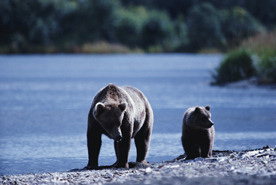
 A Mother and her cub. |
Ursus arctos
Alaskan Brown Bear |
The Brown Bear has captured the human consciousness like nearly no other animal can. It presents an image so like ourselves that we often get caught up in the "cuteness" and forget that it is a wild animal that we are dealing with. The brown bear is often seen as the cuddly buffoon of animation, and the "Teddy" bear of children and collectors alike. In reality, the brown bear is a complex and fascinating animal deserving of great respect.
The brown bear distinguishes itself from the other ursines by virtue of its shoulder hump, which is caused by muscles which are used for digging. The color of the animal varies from a light creamy color through to black. It has a dished facial profile and very long claws on the front paws. In addition, has a wider distribution than any of the other bears, and can be found throuhout the world. The animal has been found in such diverse places as Europe, Japan, North Asia, the western Canadian provinces, and the states of Washington, Idaho, Montana, Wyoming, and Alaska. This diversity does not limit itself to purely geographical happenings, as the bear is also found in a great number of different habitats as well. Brown bears can be found on the plains, in the forests, the tundra, and in subalpine mountain areas. At one time, the brown bear could be found throughout the North American continent. However, excessive hunting and destruction of the animal's habitat have all but wiped out this majestic creature.
This animal's weight varies widely throughout the course of the year. Some can even double their weigh between emerging from their dens in the Spring and returning in the Fall. The males can weigh anywhere from 300 to 860 pounds, with the females coming in somewhere between 205 and 455 pounds. The average size of these bears is difficult to pinpoint, because it seems to depend greatly on the food sources available. The island grizzlies of Alaska (Kodiak and Admiralty) are considered the largest land carnivores in the world, and live on a diet of fish and other rich food. The inland animals are smaller by some 30%.
Of the browns, people tend to be more familiar with the grizzly bear. This animal is well known for it's agressive nature, and it is for this reason that many folks believe it gets its name. Not so! The name "grizzly" comes from the "grizzling" of its fur, which gives it a lighter color at the tips of hairs.
Brown bears reach sexual maturity somewhere between their 4 1/2 to 7th years. Females and males mature at approximately the same time, but males often do not become successful breeders until they are 8-10 years old due to competition with older, stronger males. Mating between browns takes place from early May to mid-July Implantation of the egg in the uterus, however, does not occur until sometime in Oct.-Nov. 1-4 cubs are born during winter hibernation of the female, with 2 being most common, sometime between January and March. The cubs will stay with the sow up to 2 1/2 years, meaning that the female may only breed about once every 3 years or so. Given that bears generally live only until they are 20-25 years of age, this does not give very many opportunities to reproduce.
Like most other bears, the brown bears are longers; with the notable exception of females with cubs. During the mating season, males and females may pair up and mate frequently for up to two weeks. The females require the stimulation of frequent mating before they will ovulate. While fertile, she may mate with several males, leading to cubs in a litter which may not all have the same father. This is one of the factors that makes research into bears more difficult, since paternity is often hard to determine.
The home ranges of bears often overlap. The ranges of males will often intersect those of several females. Bears will not generally attack other bears which wander in to their territories. They will even congregate peacefully in places where food is plentiful such as garbage dumps and salmon streams. In such places, the big, dominant males will usually get the choice fishing areas.
Brown bears are technically carnivores, but in practice most of their diet
consists of plant matter such as sedges, grasses, bulbs, seeds, berries,
and roots. They will also eat insects, fish, and small mammals. Some of
these bears have even developed predatory practices on large animals,
including moose, caribou, and elk.
![]()